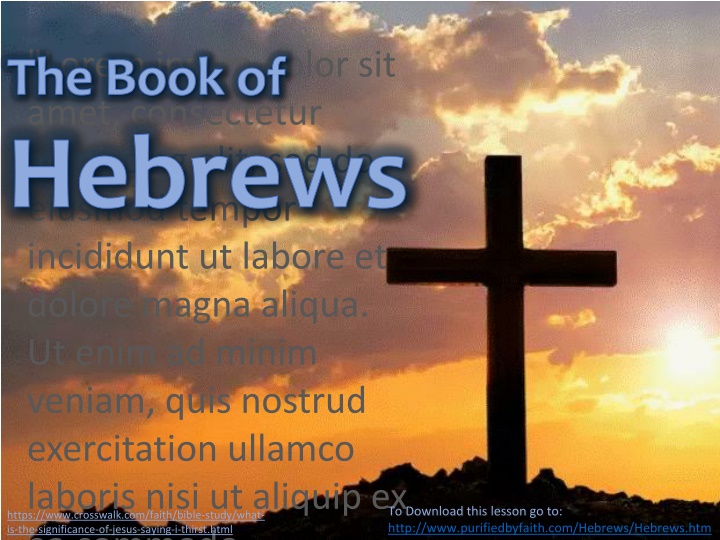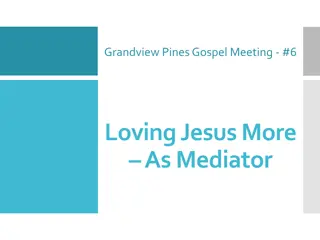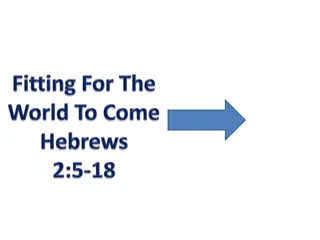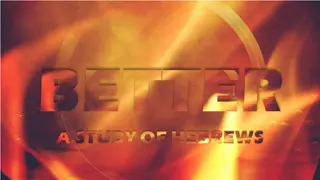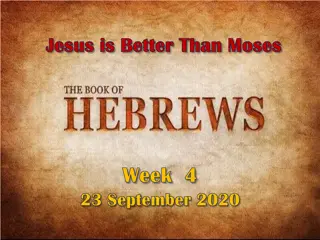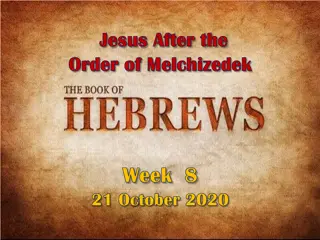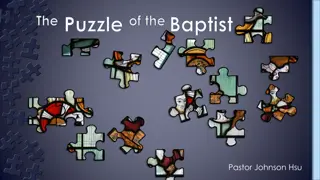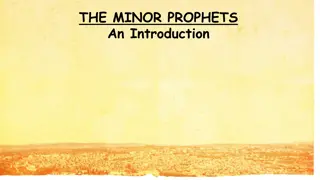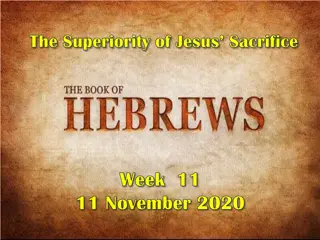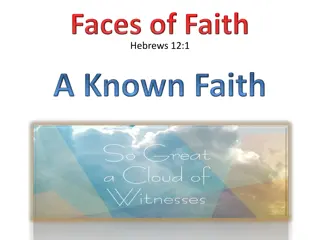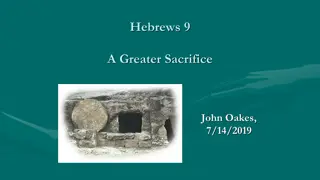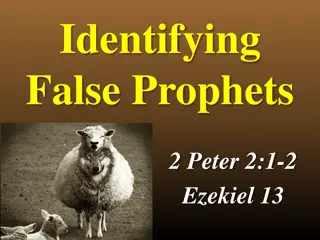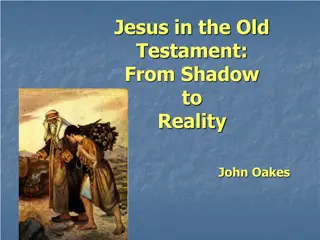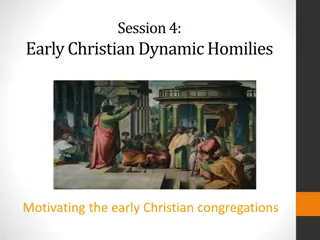Jesus Is Better Than the OT Prophets - The Book of Hebrews Summary
Delve into the Book of Hebrews' comparison of Jesus to the Old Testament prophets, angels, and Moses. Explore the superiority of Jesus' priesthood and the exhortations and warnings to persevere in faith.
Download Presentation

Please find below an Image/Link to download the presentation.
The content on the website is provided AS IS for your information and personal use only. It may not be sold, licensed, or shared on other websites without obtaining consent from the author.If you encounter any issues during the download, it is possible that the publisher has removed the file from their server.
You are allowed to download the files provided on this website for personal or commercial use, subject to the condition that they are used lawfully. All files are the property of their respective owners.
The content on the website is provided AS IS for your information and personal use only. It may not be sold, licensed, or shared on other websites without obtaining consent from the author.
E N D
Presentation Transcript
"Lorem ipsum dolor sit amet, consectetur adipiscing elit, sed do eiusmod tempor incididunt ut labore et dolore magna aliqua. Ut enim ad minim veniam, quis nostrud exercitation ullamco laboris nisi ut aliquip ex ea commodo The Book of Hebrews To Download this lesson go to: http://www.purifiedbyfaith.com/Hebrews/Hebrews.htm https://www.crosswalk.com/faith/bible-study/what- is-the-significance-of-jesus-saying-i-thirst.html
Outline of Hebrews Jesus is Better I. Jesus Is Better Than the OT Prophets (1:1-4) II. Jesus Is Better Than the Angels (1:5-2:18) III. Jesus Is Better Than Moses (3:1-4:13) IV.Jesus Priesthood Is Better Than the Levitical Priesthood (4:14-10:18) V. Concluding Exhortations and Warnings (10:19-12:29) VI.Epilogue: Final Exhortations (13:1-25)
Outline of Hebrews V. Concluding Exhortations and Warnings (10:19-12:29) A. Exhortation to Draw Near, Hold Fast, and Encourage One Another (10:19-25) B. Warning: No Hope of Forgiveness for Those Who Turn from Christ (10:26-31) C. Call to Persevere in Faith (10:32-12:3) 1. Don t Abandon Confidence but Persevere in Faith (10:32 39) 2. The Hall of Faith Description and Examples of Persevering Faith (11:1-12:3) D. Exhortations to Readers to Endure (12:4-29) Schreiner, Thomas R. Evangelical Biblical Theology Commentary - Hebrews; pp. 17-20
Outline of Hebrews 2. The Hall of Faith Description and Examples of Persevering Faith (11:1-12:3) a. Prologue: The Nature of Faith (11:1-3) b. The Faith of Those Prior to the Flood (11:4-7) c. The Faith of Abraham and His Heirs (11:8-22) d. The Faith of Moses and Those Entering the Land (11:23-31) e. A Closing Catalog of Faith (11:32-40) f. Run the Race Looking to Jesus as the Supreme Example of Faith (12:1-3) Schreiner, Thomas R. Evangelical Biblical Theology Commentary - Hebrews; pp. 17-20
Run the Race Looking to Jesus as the Supreme Example of Faith (12:1-3) 1Therefore, since we are surrounded by so great a cloud of witnesses, let us also lay aside every weight, and sin which clings so closely, and let us run with endurance the race that is set before us, 2 looking to Jesus, the founder and perfecter of our faith, who for the joy that was set before him endured the cross, despising the shame, and is seated at the right hand of the throne of God. 3 Consider him who endured from sinners such hostility against himself, so that you may not grow weary or fainthearted.
1Therefore, since we are surrounded by so great a cloud of witnesses, let us also lay aside every weight, and sin which clings so closely, and let us run with endurance the race that is set before us The writer of Hebrews begins chapter 12 with the familiar race metaphor, challenging his readers to endure in their commitment to Christ as a runner would endure in a marathon. The author makes a logical transition between chapters 11 and 12 with the opening word, therefore and the phrase, so great a cloud of witnesses which is a reference to the examples of faith just given in chapter 11. He turns the spotlight on himself and his readers by using the first person plural we as he challenges them to recognize themselves as part of the great host believers called to live by faith. Guthrie, George H. The NIV Application Commentary - Hebrews; p. 468
1Therefore, since we are surrounded by so great a cloud of witnesses, let us also lay aside every weight, and sin which clings so closely, and let us run with endurance the race that is set before us The basis for this exhortation has been laid well with the example list given in chapter 11. Authors of ancient classical literature used the image of a cloud to describe a large group of people, and our writer uses this metaphor with an added emphasis, pointing back to the multitude of persons listed or alluded to in chapter 11 as so great a cloud of witnesses. In what sense are the author and his readers surrounded by so great a cloud of witnesses ? Guthrie, George H. The NIV Application Commentary - Hebrews; p. 468
1Therefore, since we are surrounded by so great a cloud of witnesses, let us also lay aside every weight, and sin which clings so closely, and let us run with endurance the race that is set before us Some, in light of the race imagery, have understood this statement to mean that the countless thousands of God s faithful throughout the ages now sit in the stands of eternity, observing Christians as they seek to live for Christ in the world. The Greek word translated witnesses here can carry the meaning spectator or observer, as in 1 Timothy 6:12: you made the good confession in the presence of many witnesses. And furthermore, the word surrounded could bring to mind the ancient amphitheater with its tiered rows of seats where spectators would sit watching the events. Guthrie, George H. The NIV Application Commentary - Hebrews; p. 468
Ancient Greek Amphitheater https://www.ocregister.com/2019/12/14/travel-traversing-greek-ruins-brings-a-visitor-close-to-true-olympic-glory/
1Therefore, since we are surrounded by so great a cloud of witnesses, let us also lay aside every weight, and sin which clings so closely, and let us run with endurance the race that is set before us Nevertheless, it would seem that the author intends more from this image than to merely present the faithful believers of the ages as passive spectators. More than likely the author intends for us to understand that they are witnesses (Greek: marturos) in the sense that they bear witness to the Christian community of God s faithfulness and of the effectiveness of faith. Guthrie, George H. The NIV Application Commentary - Hebrews; p. 468
1Therefore, since we are surrounded by so great a cloud of witnesses, let us also lay aside every weight, and sin which clings so closely, and let us run with endurance the race that is set before us So, God has borne witness to the faithfulness of these OT believers to him ( commended in Heb 11:2,39 is from a related word), and they, in turn, bear witness to the faithfulness of God to them for succeeding generations. In this way, the great a cloud of faithful Christ- followers through history offer the readers motivation in their current struggle to stay the course in their Christian commitment. Or, as F. F. Bruce puts it, It is not so much they who look at us as we who look to them for encouragement. Guthrie, George H. The NIV Application Commentary - Hebrews; p. 468
1Therefore, since we are surrounded by so great a cloud of witnesses, let us also lay aside every weight, and sin which clings so closely, and let us run with endurance the race that is set before us The author uses a number ofathletic images drawn from the ancient Greek games (776 BC AD 393), precursors of our modern Olympics (which began in 1896). For example, the author previously described Jesus as our forerunner (Heb 6:20). Here, in verse 1, he calls his hearers to strip off every encumbering weight and run the race on the course set out before them. He will later refer to being trained by discipline (Heb 12:11) and will apply the metaphor of runners injuries to spiritual disabilities (Heb 12:12-13). In the imagery found here in verse 1, the weight to be stripped away could either be training weights or encumbering clothing. Dennis E. Johnson; ESV Expository Commentary (Volume 12) (pp. 305-306)
1Therefore, since we are surrounded by so great a cloud of witnesses, let us also lay aside every weight, and sin which clings so closely, and let us run with endurance the race that is set before us Perhaps clothing is in view here, since the word translated lay aside elsewhere in the New Testament refers to the removal of clothing (Rom 13:12; Eph 4:22; Col 3:8), and the word trained in Heb 12:11 alludes to the Greek athletic practice of competing unclothed. The weight to be discarded symbolizes sin which clings so closely or the sin which so easily entangles us (NAS) The sin to which the original readers were especially tempted was apostatizing from their allegiance to Christ under the threat of persecution (Heb 10:26-39). Their struggle against sin, which had not yet escalated to the point of bloodshed, was a struggle to hold fast to their Christian faith (Heb 12:4). Dennis E. Johnson; ESV Expository Commentary (Volume 12) (pp. 305-306)
2looking to Jesus, the founder and perfecter of our faith, who for the joy that was set before him endured the cross, despising the shame, and is seated at the right hand of the throne of God. In the previous verse, the author began by telling his readers they must run with endurance , which is another way of saying they must persevere in their Christian faith to the end. The author then tells them how to run with endurance : They must lay aside every hinderance to running well, especially the sin that so easily trips us up (NLT). And here he tells them that the way to run with endurance is by looking to Jesus. Jesus is the supreme example of faith, and believers will be motivated to persevere if they focus on him and then, by implication, follow his example. Schreiner, Thomas R. Evangelical Biblical Theology Commentary - Hebrews; p. 378
2looking to Jesus, the founder and perfecter of our faith, who for the joy that was set before him endured the cross, despising the shame, and is seated at the right hand of the throne of God. Jesus is described as the founder and perfecter of our faith. We first saw the word founder when the author used it in Heb 2:10. There we saw that it means something like champion and pioneer . He s not just a pioneer, though he does go first. And he is not a champion in the sense that we don t have to do anything. He is a champion who opens the way for us to follow. Such an interpretation fits the context here, where Jesus is set forth as the supreme example. Schreiner, Thomas R. Evangelical Biblical Theology Commentary - Hebrews; p. 378
2looking to Jesus, the founder and perfecter of our faith, who for the joy that was set before him endured the cross, despising the shame, and is seated at the right hand of the throne of God. Calling Jesus both a the founder and perfecter of our faith would seem to suggest that he initiates and completes the faith of believers. And indeed, our faith is initiated and sustained by Jesus because he has prayed to the Father that we may come to faith (Jn 17:20ff) and that our faith may not fail (Lk 22:31ff) and we have the assurance that he who began a good work in [us] will bring it to completion (Phil 1:6) But nevertheless, the incarnate Son is himself the man of faith par excellence, and this seems to be the primary sense intended by the original Greek here which reads literally, thefounder and perfecter of faith (the word our is not in the original). Philip E. Hughes; A Commentary on the Epistle to the Hebrews (p. 522)
2looking to Jesus, the founder and perfecter of our faith, whofor the joy that was set before him endured the cross, despising the shame, and is seated at the right hand of the throne of God. Jesus, in his unique and solitary struggle, had a goal on which his attention was inflexibly fixed, namely the joy that was set before him . Jesus joy was to complete the work of reconciliation he had come to perform for our eternal benefit and for the glory of his Father s name (cf. Jn 12:28), thereby bringing to completion all of God s purposes for creation and for his elect people. Jesus joy is the joy of heaven over every sinner who repents and returns to the Father s home, over every lost sheep that is found, over every son that was dead and is alive again (Lk 15:6ff, 24, 32) Philip E. Hughes; A Commentary on the Epistle to the Hebrews (pp. 523-525)
2looking to Jesus, the founder and perfecter of our faith, who for the joy that was set before him endured the cross, despising the shame, and is seated at the right hand of the throne of God. It was for , that is for the sake of (NEB), this joy that Jesus endured the cross. Which confirms that, in our author s mind, the death of Christ on the cross was the central purpose of his coming to earth Calvary was the reason for Bethlehem! The road to the joy ahead was the way of the cross . The incarnate Son, accordingly, set his face to go to Jerusalem, knowing full well this meant arrest, false accusation, unjust condemnation, and the extremes of suffering and death, but also thereafter resurrection, exaltation, and joy (Mk 8:31; 9:12, 31; 10:33ff; Lk 9:22, 44; 17:25; 18:31ff) Philip E. Hughes; A Commentary on the Epistle to the Hebrews (pp. 523-525)
2looking to Jesus, the founder and perfecter of our faith, who for the joy that was set before him endured the cross, despising the shame, and is seated at the right hand of the throne of God. Jesus determination to endure the cross meant despising the shame, since nothing more disgraceful could happen to any man than to suffer public crucifixion, a fate designed for the basest of criminals and the lowest of social outcasts. It was a punishment so degrading, that no Roman citizen was allowed to be subjected to it. But for Jesus, the cross was the gateway to joy , his joy and ours; for Jesus who endured the cross, despising the shame is now seated at the right hand of the throne of God. Philip E. Hughes; A Commentary on the Epistle to the Hebrews (pp. 523-525)
2looking to Jesus, the founder and perfecter of our faith, who for the joy that was set before him endured the cross, despising the shame, and is seated at the right hand of the throne of God. Here the author picks up again one of the central themes of this letter Jesus fulfillment of Psalm 110. The prophesy of Ps 110:1 is fulfilled in Jesus being seated at the right hand of the throne of God and reigning over all (cf. Heb 1:3, 13; 8:1; 10:12-13). Just as Moses renounced the temporary pleasures of sin for the sake of reward that lay before him (Heb 11:24-26), so too Jesus endured the cross for the reward. The application to the readers is clear. They too must endure to the end, being willing to endure any suffering since they know they will ultimately enjoy a great reward. Schreiner, Thomas R. Evangelical Biblical Theology Commentary - Hebrews; p. 378
3 Consider him who endured from sinners such hostility against himself, so that you may not grow weary or fainthearted. The author continues to elaborate on Jesus role as an example. The readers must run the race to the end by looking at Jesus who endured the cross. The readers are urged to consider Jesus, and again his endurance is emphasized, which is what the readers are in need of right now. Jesus endured remarkable hostility of sinners against himself. No doubt, the author alludes here to a similar hostility which the readers experienced, so he calls upon them to consider the example of Jesus who was not exempt from the same opposition by sinners. Schreiner, Thomas R. Evangelical Biblical Theology Commentary - Hebrews; p. 379
3 Consider him who endured from sinners such hostility against himself, so that you may not grow weary or fainthearted. The author is concerned the readers will grow weary or fainthearted and give up. By considering what Jesus suffered on their behalf, the author hopes that they will come away with fresh resolve in a world that remains unfriendly and opposed to their Christian faith and not give up. Giving up is another way of describing apostasy. Giving up is the opposite of enduring to the end. Jesus endured by keeping his eyes on the ultimate reward, and we should do the same. Schreiner, Thomas R. Evangelical Biblical Theology Commentary - Hebrews; p. 379
A Brief Summary of the Message of Today s Text Applied to Us (12:1-3) We as believers are in a race , which is long and difficult, and they must finish the race in order to receive the prize. But we are not alone in the race. Many ( so great a cloud of witnesses see chapter 11) have run this race before us and bear witness to the value of doing so. We must throw off everything off that hinders us from running and finishing the race. Schreiner, Thomas R. Evangelical Biblical Theology Commentary - Hebrews; pp. 368-369
A Brief Summary of the Message of Today s Text (12:1-3) Jesus is our supreme example, for he endured to the end of his race, suffering agony and opposition of those who hated him. But he was rewarded for his obedience and endurance, for he now reigns at the right hand of God. So too, we must be willing to suffer with Jesus and for him. Jesus is the source of our faith, but at the same time we should continue to believe and keep our eyes on Jesus as the ultimate example. The race won t last forever, and knowing there is a great reward ahead should motivate us to keep running. Schreiner, Thomas R. Evangelical Biblical Theology Commentary - Hebrews; pp. 368-369
Class Discussion Time https://www.weareteachers.com/moving-beyond-classroom-discussions/
*Class Discussion Time Figurative language in a text is meant to stimulate the imagination, inviting a reader to enter into the image and connect with the relevant material the image has to offer. Today we saw the author make extensive use of the image of running a race as a way of faithfully living the Christian life. The key to dealing with such images is to discern the connecting point between the image and the topic at hand. There are many ways, for example, in which the author of Hebrews does not intend the race imagery to be read. For example: The author certainly does not play up the idea of competition, as in God wants you to beat the other guy. Nor does he mean to emphasize here that God gives Christians the ability to overcome all obstacles. There is no hint of the race belongs to the strong, or pace yourself and you will get farther! Therefore, we need to exercise restraint in the use of this image. Guthrie, George H. The NIV Application Commentary - Hebrews; p. 468
*Class Discussion Time Nevertheless, as I see it, the race image provides at least three primary concepts that overlap with the Christian life. How many would you say there are? Name them. Some things in life must be rejected if we are to run effectively. The Christian life, like a long-distance run, is difficult and, therefore, takes sustained effort. If we are to live for God in a faithful manner, a healthy view of Christ and a relationship with him are paramount. Guthrie, George H. The NIV Application Commentary - Hebrews; p. 468
*Class Discussion Time We saw in today s text that we must lay aside every weight, and sin which clings so closely , that is we must throw off every sin that might easily trip us up in our pursuit of the Christian faith. The sin to which the original hearers were especially tempted was apostatizing from their allegiance to Christ due to societal pressures and the threat of persecution and returning to their former Judaism (Heb 10:26-39). What are some common sinful patterns of thinking and/or living that you believe might pose a similar threat in our day?
